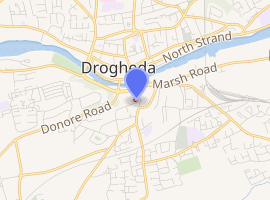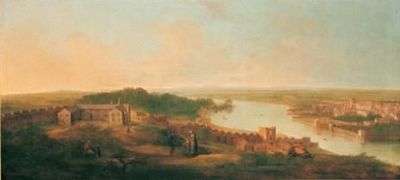Millmount Fort
Millmount is a large fortified complex situated on a great mound on the South bank of the River Boyne located in Drogheda, County Louth, Ireland. The fort has played a crucial part in Drogheda's history and has been a dominant feature from Norman settlement, to Cromwell's invasion to the more recent Civil War in 1922, in which the famous Martello tower was shelled and all but destroyed. Today the complex houses the Millmount Museum which houses a wide variety of artifacts of local and national importance. The complex is Drogheda's most dominant feature, clearly visible from all parts of the town. The Martello tower is affectionately known as "The Cup and Saucer" by locals. The whole fort is a national monument and has been designated as Drogheda's Cultural Quarter.
| Millmount | |
|---|---|
 | |

| |
| Former names | Richmond Barracks |
| Alternative names | Cup and Saucer |
| General information | |
| Type | Fortification |
| Address | Millmount |
| Town or city | Drogheda |
| Country | Ireland |
| Construction started | 12th Century CE |
| Owner | Old Drogheda Society |
| Website | |
| http://www.millmount.net/ | |
History
It has been fortified in historical times since the early 12th Century CE when the invading Normans built a mote and bailey on what was probably originally a neolithic passage grave similar to Newgrange. In Irish cosmology, it is often assumed to be the burial place of Amhairgin mac Míled, whose name ("Amhair" = singing; "gin" = give birth) indicates that in ancient Irish mythology he was regarded as the originator of the arts of song, poetry and music. The shamanistic Early Irish poem "The Song of Amhairgin", uttered by him in the story of his entry into Ireland by the River Boyne, was therefore conventionally regarded as the first Irish poem.[1]

Hugh De Lacy, one of the Normans who came to Ireland after Strongbow, built the original fort circa 1172, having been granted the Kingdom of Meath by Henry II. Later a stone castle was built on the site. This castle formed part of the defences of the town during the siege of Drogheda during the Cromwellian conquest of Ireland in 1649. The fort's English defenders attempted to surrender to Parliamentarian troops under Oliver Cromwell but were massacred when they gave themselves up on 11 September 1649. The complex was later called Richmond Barracks. Some of the present buildings, in the courtyard, were built circa 1714. After the unrest and rebellions of the 1790s and the Act of Union in 1800 the complex was re-fortified and the present tower built.

The fort suffered considerable damage during the Irish Civil War. It was occupied by Anti-Treaty forces and on 4 July 1922, it became the target of shelling by the army of the Irish Free State. The Free State Forces under Michael Collins had been given extensive support by the British Army at the express wish of Winston Churchill who insisted that the Republican Forces be crushed. Using the same British Army 18 pounder artillery piece which had shelled the Republican H.Q. in the Four Courts in Dublin some days earlier the Free State Forces bombarded Millmount fort for several hours before the Republican garrison retreated. It has been restored in 2000 and is now open to the public as a military museum.[2]
Museum
The Museum houses a wide variety of artifacts of local and national importance. Chief amongst the attractions is the unique collection of Guild and Trade Banners. This collection is recognised by Ireland's National Museum as being of special significance and includes the only remaining guild banners in Ireland. Popular exhibits at the Millmount Museum include an authentic 18th century Irish folk kitchen, dairy and laundry, and the Irish History Room which details the major events in Ireland's history.
List of structures
| Number | Structure | Type | Year |
|---|---|---|---|
| Town Wall | Fortification | c.13thC | |
| Martello Tower[3] | Fortification | 1808 | |
| No.1 | Barrack Building | Guard house, Arch and Gate[4][5] | 1831 |
| No.2 | Barrack Building | Officers Mess | 1850 |
| No.3 | Barrack Building[6] | Officers Mess | 1850 |
| No.4[7] | Barrack Building | Glazed extension to rear of soldiers' billeting house | 1850 |
| No.5[8] | Barrack Building | Soldiers' billeting house | 1714 |
| No.6[9] | Barrack Building | Soldiers' billeting house | 1714 |
| No.7[10] | Barrack Building | Soldiers' billeting house | 1714 |
| No.8[11] | Barrack Building | Soldiers' billeting house | 1714 |
| No.9[12] | Barrack Building | Soldiers' billeting house | 1714 |
| No.10[13] | Barrack Building | Soldiers' billeting house | 1714 |
| No.11 | Barrack Building | Soldiers' billeting house | 1714 |
| No.12 | Barrack Building[14] | Soldiers' billeting house | 1714 |
| No.13 | Barrack Building[15] | Soldiers' billeting house | 1714 |
| No.14 | Governor's House[16] | Governor's House | Late 18th Century (Reportedly built in conjunction with the adjacent Martello tower in 1808) |
| No.15 | Barrack Building | Soldiers' billeting house | 1810 |
| No.16 | Barrack Building | Soldiers' billeting house | 1810 |
| 16 Mount Saint Oliver[17] | Barrack Building | Soldiers' billeting house | Late 18th Century (Reportedly built in conjunction with the adjacent Martello tower in 1808) |
Gallery
 Millmount Fort overlooks the town of Drogheda below
Millmount Fort overlooks the town of Drogheda below Governor's House
Governor's House Reenactors ("86th Regiment of Foot") at the fort
Reenactors ("86th Regiment of Foot") at the fort Reenactors ("Royal Artillery") at Millmount
Reenactors ("Royal Artillery") at Millmount View of Drogheda's south side
View of Drogheda's south side Millmount Fort as viewed from the Visitor Centre
Millmount Fort as viewed from the Visitor Centre
External links
References
- "Archived copy" (PDF). Archived from the original (PDF) on 4 March 2016. Retrieved 27 June 2014.CS1 maint: archived copy as title (link)
- http://www.buildingsofireland.ie/niah/search.jsp?type=record&county=LH®no=13622082
- http://www.buildingsofireland.ie/niah/search.jsp?type=record&county=LH®no=13622075
- http://www.buildingsofireland.ie/niah/search.jsp?type=record&county=LH®no=13622074
- http://www.buildingsofireland.ie/niah/search.jsp?type=record&county=LH®no=13622076
- http://www.buildingsofireland.ie/niah/search.jsp?type=record&county=LH®no=13622077&print=true
- http://www.buildingsofireland.ie/niah/search.jsp?type=record&county=LH®no=13622077&print=true
- http://www.buildingsofireland.ie/niah/search.jsp?type=record&county=LH®no=13622077&print=true
- http://www.buildingsofireland.ie/niah/search.jsp?type=record&county=LH®no=13622077&print=true
- http://www.buildingsofireland.ie/niah/search.jsp?type=record&county=LH®no=13622077&print=true
- http://www.buildingsofireland.ie/niah/search.jsp?type=record&county=LH®no=13622077&print=true
- http://www.buildingsofireland.ie/niah/search.jsp?type=record&county=LH®no=13622077&print=true
- http://www.buildingsofireland.ie/niah/search.jsp?type=record&county=LH®no=13622078
- http://www.buildingsofireland.ie/niah/search.jsp?type=record&county=LH®no=13622079&print=true
- http://www.buildingsofireland.ie/niah/search.jsp?type=record&county=LH®no=13622080
- http://www.buildingsofireland.ie/niah/search.jsp?type=record&county=LH®no=13622081
- "Archived copy" (PDF). Archived from the original (PDF) on 4 March 2016. Retrieved 27 June 2014.CS1 maint: archived copy as title (link)